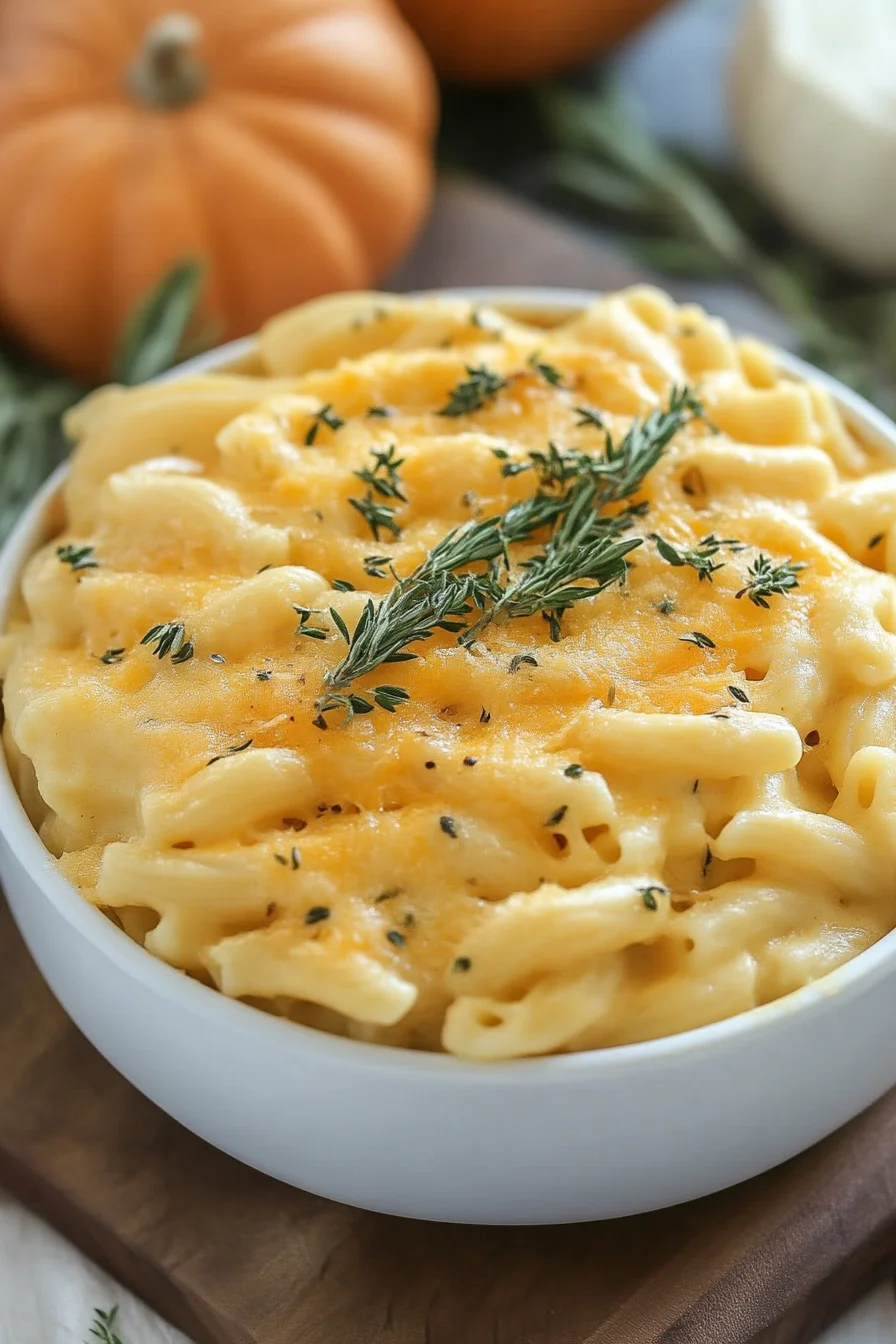Butternut Squash Mac and Cheese is my ultimate comfort food with a nutritious twist! I love how the sweet, earthy butternut squash creates a creamy base that blends perfectly with the sharp cheddar. This dish has become a staple in my household, especially during fall and winter months when I’m craving something warm and satisfying. It’s so much more colorful than traditional mac and cheese, and my kids don’t even realize they’re eating vegetables! The best part? It’s actually pretty simple to make, so you can enjoy this upgraded mac and cheese any night of the week.
Table of Contents
Ingredients for Butternut Squash Mac and Cheese
- 1 pound butternut squash, peeled, seeded, and cut into 1/2-inch cubes (or 1 15-ounce bag frozen cubed butternut squash – no need to thaw)
- 1 1/2 cups whole milk
- 1/2 cup water
- 1/2 teaspoon kosher salt, plus more for the pasta water
- 1/4 teaspoon ground white pepper
- 1/4 teaspoon freshly grated nutmeg
- 1 pound dried small pasta shells
- 1 1/2 cups grated sharp cheddar cheese (about 6 ounces)
- 1/4 cup finely grated Parmesan cheese
- 2 ounces cream cheese, at room temperature
How To Make Butternut Squash Mac and Cheese
- Prepare the squash sauce: In a large pot, combine the butternut squash cubes, whole milk, water, and 1/2 teaspoon kosher salt. Bring this mixture to a simmer over medium-high heat. Once simmering, reduce the heat to medium, cover the pot, and cook until the squash becomes tender – this takes about 20 minutes for fresh squash. If you’re using frozen squash, it will become tender much faster, usually by the time the mixture comes to a simmer, so you can cook it uncovered. Once tender, turn off the heat and set the pot aside.
- Cook the pasta: While the squash is cooking, bring another large pot of water to a boil. Don’t forget to add salt to the water – I like to make it “as salty as the sea” for the best-tasting pasta. Add the small pasta shells and cook according to the package directions until they’re al dente, which usually takes about 6-8 minutes. Drain the pasta and set it aside.
- Blend the sauce: Take your immersion blender and purée the squash and milk mixture until it becomes a smooth, velvety sauce. If you don’t have an immersion blender, you can carefully transfer the mixture to a regular blender, purée until smooth, then return it to the pot. Once smooth, stir in the nutmeg and white pepper.
- Combine everything: Add the cooked pasta shells to the squash sauce. Then add the grated sharp cheddar, Parmesan, and room-temperature cream cheese. Stir everything together until the pasta is evenly coated and all the cheeses have melted into the sauce, creating a creamy, cheesy masterpiece.
- Serve immediately: This mac and cheese is best enjoyed right away while it’s hot and at its creamiest. If desired, you can sprinkle a little extra grated cheese or a touch of black pepper on top before serving.
Storage And Freezing
Refrigerator Storage: I find that this Butternut Squash Mac and Cheese keeps well in an airtight container in the refrigerator for up to 3-4 days. The sauce might thicken up a bit in the fridge, but that’s normal.
Freezing: You can freeze this mac and cheese, although the texture might change slightly upon thawing. To freeze, let it cool completely, then store in freezer-safe containers or heavy-duty freezer bags for up to 2 months. I like to portion it into individual servings before freezing for easy reheating.
Reheating: To reheat refrigerated mac and cheese, add a splash of milk and microwave in 30-second intervals, stirring between each, until hot. You can also reheat it on the stovetop over medium-low heat, adding a bit of milk to loosen the sauce as needed. For frozen mac and cheese, thaw overnight in the refrigerator before reheating.
Tips for Success
- Squash selection: Choose a butternut squash that feels heavy for its size and has a hard, beige skin without soft spots. The heavier it feels, the more flesh it contains!
- Time-saving tip: Using pre-cut or frozen butternut squash saves a ton of prep time. I often use the frozen kind when I’m in a hurry.
- Cheese matters: Freshly grated cheese melts much better than pre-shredded cheese, which contains anti-caking agents that can make your sauce less smooth.
- Don’t overcook the pasta: Since the pasta will continue to absorb moisture from the sauce, I always cook it just to al dente (or even a minute under) to prevent it from becoming mushy.
- Add more vegetables: Sometimes I add steamed broccoli, peas, or spinach to make it even more nutritious. Just fold them in with the cheese and pasta.
Kitchen tools required
- Large pot for cooking the squash sauce
- Second large pot for cooking pasta
- Immersion blender (or regular blender)
- Sharp knife and cutting board (if using fresh squash)
- Vegetable peeler (for fresh squash)
- Cheese grater
- Measuring cups and spoons
- Wooden spoon or silicone spatula for stirring
Storing leftovers
Leftover Butternut Squash Mac and Cheese can make for some creative meals! Here are my favorite ways to use it:
- Mac and cheese patties: Form cold leftovers into patties, coat with breadcrumbs, and pan-fry until golden for a crispy treat.
- Stuffed peppers: Spoon leftover mac and cheese into halved bell peppers, top with more cheese, and bake until the peppers are tender.
- Mac and cheese soup: Add chicken broth to thin out the mac and cheese, then heat it up for a quick and comforting soup.
- Lunchbox thermos: My kids love when I heat up leftovers and pack them in a thermos for school lunch.
Recipe tips
- Getting the perfect texture: If your sauce seems too thick after blending, add a splash more milk. If it’s too thin, let it simmer uncovered for a few more minutes to reduce.
- Flavor boosters: For extra flavor, try adding a pinch of cayenne pepper, a teaspoon of Dijon mustard, or a dash of smoked paprika to the sauce.
- Make it a complete meal: Add cooked chicken, bacon bits, or sautéed mushrooms to transform this side dish into a hearty main course.
- Baked version: For a crispy top, transfer the finished mac and cheese to a baking dish, sprinkle with a mixture of Parmesan cheese and panko breadcrumbs, and broil for 2-3 minutes until golden.
- Seasoning adjustment: Always taste before serving and adjust the salt and pepper as needed. The cheese adds saltiness, so you might not need additional salt.
- Squash roasting option: For a deeper flavor, you can roast the butternut squash in the oven (400°F for about 25-30 minutes) instead of simmering it. Then blend it with warm milk before proceeding with the recipe.
Recipe FAQs
Q: Can I use a different type of squash?
A: Yes! Sweet potatoes, pumpkin, or acorn squash work well as substitutes for butternut squash in this recipe. The flavor will vary slightly, but they’ll all give you that creamy, slightly sweet base.
Q: How can I make this recipe dairy-free?
A: You can substitute the whole milk with unsweetened almond or oat milk, and use your favorite dairy-free cheese alternatives. Nutritional yeast can help add that cheesy flavor too.
Q: Can I use different pasta shapes?
A: Absolutely! While small shells are great for catching the sauce, elbows, cavatappi, or even penne work well too. Just adjust cooking times according to the package directions.
Q: Is there a way to make this gluten-free?
A: Simply swap in your favorite gluten-free pasta. The sauce itself is naturally gluten-free, so it’s an easy adaptation.
Q: My kids don’t like visible squash. Will they notice it in this recipe?
A: Since the squash is completely puréed into the sauce, most kids won’t even realize it’s there! The cheese flavor typically dominates, and the squash just adds creaminess and a subtle sweetness.
Q: Can I make this ahead of time for a party?
A: Yes! Make it up to a day ahead, but prepare it slightly underdone since it will continue to absorb the sauce. When reheating, add a splash of milk and stir frequently to bring back the creamy consistency.
Q: Why use white pepper instead of black pepper?
A: White pepper blends in seamlessly without leaving black specks in your creamy sauce. It’s purely aesthetic, so feel free to use black pepper if that’s what you have on hand!

Butternut Squash Mac and Cheese
- Total Time: 1 hour 20 minutes
- Yield: Serves 8
- Diet: Vegetarian
Ingredients
- 1 pound butternut squash, peeled, seeded, and cut into 1/2-inch cubes (or 1 15-ounce bag frozen cubed butternut squash – no need to thaw)
- 1 1/2 cups whole milk
- 1/2 cup water
- 1/2 teaspoon kosher salt, plus more for the pasta water
- 1/4 teaspoon ground white pepper
- 1/4 teaspoon freshly grated nutmeg
- 1 pound dried small pasta shells
- 1 1/2 cups grated sharp cheddar cheese (about 6 ounces)
- 1/4 cup finely grated Parmesan cheese
- 2 ounces cream cheese, at room temperature
Instructions
- Prepare the squash sauce: In a large pot, combine the butternut squash cubes, whole milk, water, and 1/2 teaspoon kosher salt. Bring this mixture to a simmer over medium-high heat. Once simmering, reduce the heat to medium, cover the pot, and cook until the squash becomes tender – this takes about 20 minutes for fresh squash. If you’re using frozen squash, it will become tender much faster, usually by the time the mixture comes to a simmer, so you can cook it uncovered. Once tender, turn off the heat and set the pot aside.
- Cook the pasta: While the squash is cooking, bring another large pot of water to a boil. Don’t forget to add salt to the water – I like to make it “as salty as the sea” for the best-tasting pasta. Add the small pasta shells and cook according to the package directions until they’re al dente, which usually takes about 6-8 minutes. Drain the pasta and set it aside.
- Blend the sauce: Take your immersion blender and purée the squash and milk mixture until it becomes a smooth, velvety sauce. If you don’t have an immersion blender, you can carefully transfer the mixture to a regular blender, purée until smooth, then return it to the pot. Once smooth, stir in the nutmeg and white pepper.
- Combine everything: Add the cooked pasta shells to the squash sauce. Then add the grated sharp cheddar, Parmesan, and room-temperature cream cheese. Stir everything together until the pasta is evenly coated and all the cheeses have melted into the sauce, creating a creamy, cheesy masterpiece.
- Serve immediately: This mac and cheese is best enjoyed right away while it’s hot and at its creamiest. If desired, you can sprinkle a little extra grated cheese or a touch of black pepper on top before serving.
Notes
- Squash selection: Choose a butternut squash that feels heavy for its size and has a hard, beige skin without soft spots. The heavier it feels, the more flesh it contains!
- Time-saving tip: Using pre-cut or frozen butternut squash saves a ton of prep time. I often use the frozen kind when I’m in a hurry.
- Cheese matters: Freshly grated cheese melts much better than pre-shredded cheese, which contains anti-caking agents that can make your sauce less smooth.
- Don’t overcook the pasta: Since the pasta will continue to absorb moisture from the sauce, I always cook it just to al dente (or even a minute under) to prevent it from becoming mushy.
- Add more vegetables: Sometimes I add steamed broccoli, peas, or spinach to make it even more nutritious. Just fold them in with the cheese and pasta.
- Prep Time: 20 minutes
- Cook Time: 1 hour
- Category: Dinner
- Method: Baking
- Cuisine: American
Nutrition
- Serving Size: About 1 cup
- Calories: 240
- Sugar: 5g
- Sodium: 180mg
- Saturated Fat: 3.5g
- Carbohydrates: 32g
- Fiber: 4g
- Protein: 16g
- Cholesterol: 50mg

